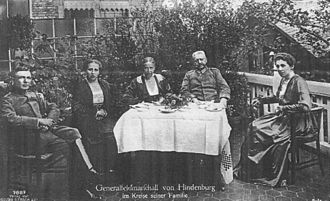Gertrud von Hindenburg
Gertrud Wilhelmine von Beneckendorff and von Hindenburg (born December 4, 1860 in Magdeburg , † May 14, 1921 in Hanover ) was a German nobleman and philanthropist . She was the wife of Paul von Hindenburg , the head of the German Army Command in the second half of the First World War and later German President (1925–1934).
Live and act
Gertrud von Hindenburg was born in 1860 as the daughter of the Prussian major general Oskar von Sperling (1814–1872) and his wife Pauline von Klaß. Her older brother was the infantry general Kurt von Sperling (1850-1914).
In Stettin Gertrud von Sperling met Paul von Hindenburg in the mid-1870s, who was part of the General Command of the II Army Corps. On September 24, 1879, the two married in Stettin, after Hindenburg's promotion to captain in 1878 had created the material conditions for marriage. The connection resulted in four children: the daughter Irmengard Pauline (born November 14, 1880; † 1948), a stillborn son without a name (1881), the son Oskar Wilhelm (born January 31, 1883; † February 12, 1960) and the daughter Annemarie (born November 29, 1891 in Berlin, † April 8, 1978 in Hanover).
Paul von Hindenburg saw in his wife, as he wrote in his autobiography, published in 1920, "a loving wife who faithfully and tirelessly shared joys and sorrows, all worries and work with me and thus became my best friend and comrade". Although Gertrud von Hindenburg primarily - according to the statement of a relative - "lived for her family" and tried to "shield her husband from any inconvenience and worry", she was considered a woman of esprit. In traditional reports she is consistently described as witty, educated and "more well-read than her husband". She had a lively interest in theater, music and painting and corresponded with numerous prominent contemporaries, such as the industrialist and politician Walther Rathenau , whom she urged shortly before her death to accept the office of Reich Foreign Minister. The sources also agree that Gertrud von Hindenburg was lively, amiable and spirited and thus formed an “ideal complement” to her “closed, calm and heavy-blooded” husband.

After their marriage, Ms. von Hindenburg lived at the respective places of use of her husband as a troop commander and staff officer (in Stettin, Karlsruhe , Berlin and Magdeburg). After Hindenburg's retirement in 1911, they both moved into a house in Hanover . After her husband was reactivated in World War I and his rise to the highest military positions, she mainly took on charitable tasks. So she took care of the war wounded and founded the Frau Gertrud von Hindenburg Foundation for the moral strengthening of German youth. After the war, she lived again with her husband in Hanover, where she died of cancer in 1921.
After her death, she was buried in Hanover. When a few years later (1927) the East Prussian ancestral home of the von Hindenburg family, the Neudeck manor in Rosenberg, returned to the property of the family, Gertrud von Hindenburg was exhumed at her husband's request and buried in the park of Neudeck. However, Paul von Hindenburg's wish to find his final resting place in the same place after his death was not fulfilled after his death on August 2, 1934. Adolf Hitler forbade the general's burial in Neudeck, but instead had his wife's coffin exhumed again at the beginning of August 1934 and the two dead people brought together to the Tannenberg Memorial near the East Prussian town of Hohenstein. There the dead were buried in heavy zinc coffins in the midst of numerous dead from the First World War.
When the Red Army reached East Prussia in the spring of 1945 , Hitler had the coffins of the von Hindenburgs recovered from the Tannenberg memorial on January 12, 1945 and shipped from Königsberg on the Emden cruiser to West Germany. At the end of the war there were both coffins, together with the graves of Kings Friedrich Wilhelm I and Friedrich II of Prussia, the flags and standards of the German army from 1914–1918, the files of the Foreign Office, pictures from Prussian state museums and the library von Sanssouci and the Prussian Crown Jewels in a salt mine in Bernterode in Eichsfeld , Thuringia , where they were discovered by the 1st US Army at the end of April 1945 . In August 1946 the remains of Gertrud von Hindenburg were buried next to those of her husband in the tower hall of the Elisabeth Church in Marburg .
literature
- Ludwig Hoppe: The heart of the Hindenburg house. The memory of a noble German woman . Office of the Gertrud von Hindenburg Foundation, 1928.
Individual evidence
- ↑ Paul von Hindenburg: From my life, 1920, p. 51.
- Jump up ↑ Helene von Hindenburg and Nostitz: Hindenburg at Home , 1931, p. 83.
- ↑ Hans-Otto Meissner: Young Years in the Reich President's Palace , 1988, p. 217.
- ^ Hartmut Pogge von Strandmann: Walther Rathenau. Diary 1907–1922 , Düsseldorf 1967, p. 19. See also: L. Joseph Heid: The Prussian-German Jude ( Memento from June 27, 2008 in the Internet Archive ), in: Jüdische Zeitung, July 2007, accessed online on 11. November 2008.
- ↑ Hans-Otto Meissner : Young Years in the Reich President's Palace , 1988, p. 217.
| personal data | |
|---|---|
| SURNAME | Hindenburg, Gertrud von |
| ALTERNATIVE NAMES | Hindenburg, Gertrud Wilhelmine von (full name); Sperling, Gertrud Wilhelmine von (maiden name) |
| BRIEF DESCRIPTION | German nobleman and philanthropist |
| DATE OF BIRTH | 4th December 1860 |
| PLACE OF BIRTH | Magdeburg |
| DATE OF DEATH | May 14, 1921 |
| Place of death | Hanover |
